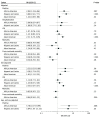Disparities in COVID-19 Outcomes by Race, Ethnicity, and Socioeconomic Status: A Systematic-Review and Meta-analysis
- PMID: 34762110
- PMCID: PMC8586903
- DOI: 10.1001/jamanetworkopen.2021.34147
Disparities in COVID-19 Outcomes by Race, Ethnicity, and Socioeconomic Status: A Systematic-Review and Meta-analysis
Erratum in
-
Error in Figures 1 and 2.JAMA Netw Open. 2021 Dec 1;4(12):e2144237. doi: 10.1001/jamanetworkopen.2021.44237. JAMA Netw Open. 2021. PMID: 34932110 Free PMC article. No abstract available.
-
Error in Interpretation of Mortality.JAMA Netw Open. 2022 Feb 1;5(2):e222170. doi: 10.1001/jamanetworkopen.2022.2170. JAMA Netw Open. 2022. PMID: 35201313 Free PMC article. No abstract available.
Abstract
Importance: COVID-19 has disproportionately affected racial and ethnic minority groups, and race and ethnicity have been associated with disease severity. However, the association of socioeconomic determinants with racial disparities in COVID-19 outcomes remains unclear.
Objective: To evaluate the association of race and ethnicity with COVID-19 outcomes and to examine the association between race, ethnicity, COVID-19 outcomes, and socioeconomic determinants.
Data sources: A systematic search of PubMed, medRxiv, bioRxiv, Embase, and the World Health Organization COVID-19 databases was performed for studies published from January 1, 2020, to January 6, 2021.
Study selection: Studies that reported data on associations between race and ethnicity and COVID-19 positivity, disease severity, and socioeconomic status were included and screened by 2 independent reviewers. Studies that did not have a satisfactory quality score were excluded. Overall, less than 1% (0.47%) of initially identified studies met selection criteria.
Data extraction and synthesis: Preferred Reporting Items for Systematic Reviews and Meta-Analyses (PRISMA) guidelines were followed. Associations were assessed using adjusted and unadjusted risk ratios (RRs) and odds ratios (ORs), combined prevalence, and metaregression. Data were pooled using a random-effects model.
Main outcomes and measures: The main measures were RRs, ORs, and combined prevalence values.
Results: A total of 4 318 929 patients from 68 studies were included in this meta-analysis. Overall, 370 933 patients (8.6%) were African American, 9082 (0.2%) were American Indian or Alaska Native, 101 793 (2.4%) were Asian American, 851 392 identified as Hispanic/Latino (19.7%), 7417 (0.2%) were Pacific Islander, 1 037 996 (24.0%) were White, and 269 040 (6.2%) identified as multiracial and another race or ethnicity. In age- and sex-adjusted analyses, African American individuals (RR, 3.54; 95% CI, 1.38-9.07; P = .008) and Hispanic individuals (RR, 4.68; 95% CI, 1.28-17.20; P = .02) were the most likely to test positive for COVID-19. Asian American individuals had the highest risk of intensive care unit admission (RR, 1.93; 95% CI, 1.60-2.34, P < .001). The area deprivation index was positively correlated with mortality rates in Asian American and Hispanic individuals (P < .001). Decreased access to clinical care was positively correlated with COVID-19 positivity in Hispanic individuals (P < .001) and African American individuals (P < .001).
Conclusions and relevance: In this study, members of racial and ethnic minority groups had higher risks of COVID-19 positivity and disease severity. Furthermore, socioeconomic determinants were strongly associated with COVID-19 outcomes in racial and ethnic minority populations.
Conflict of interest statement
Figures




References
-
- WHO Health Emergency Dashboard . Accessed October 12, 2021. https://extranet.who.int/publicemergency
-
- Shah SJ, Barish PN, Prasad PA, et al. ; CZB CLIAhub Consortium . Clinical features, diagnostics, and outcomes of patients presenting with acute respiratory illness: a retrospective cohort study of patients with and without COVID-19. EClinicalMedicine. 2020;27(27):100518. doi:10.1016/j.eclinm.2020.100518 - DOI - PMC - PubMed
Publication types
MeSH terms
LinkOut - more resources
Full Text Sources
Medical
Miscellaneous

